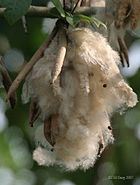- Synthetic fiber
-
Part of a series on Fiber  Animal
Animal
Alpaca · Angora · Byssus · Camel hair · Cashmere · Catgut · Chiengora · Guanaco · Llama · Mohair · Pashmina · Qiviut · Rabbit · Silk · Sinew · Spider silk · Wool · Vicuña · Yak
Vegetable
Abacá · Bamboo · Coir · Cotton · Flax (Linen) · Hemp · Jute · Kapok · Kenaf · Piña · Raffia · Ramie · Sisal · Wood
Mineral
AsbestosSynthetic fibersCellulose
Acetate · Triacetate · Art silk · Bamboo · Lyocell Rayon · Modal Rayon · Rayon
Mineral
Glass] · Carbon (Tenax) · Basalt · Metallic
Polymer
Acrylic · Aramid (Twaron · Kevlar · Technora · Nomex) · Microfiber · Modacrylic · Nylon · Olefin · Polyester · Polyethylene (Dyneema · Spectra) · Spandex · Vinylon · Vinyon · ZylonAgriculture Portal · Engineering Portal
CategorySynthetic fibers are the result of extensive research by scientists to improve on naturally occurring animal and plant fibers. In general, synthetic fibers are created by forcing, usually through extrusion, fiber forming materials through holes (called spinnerets) into the air, forming a thread. Before synthetic fibers were developed, artificially manufactured fibers were made from cellulose, which comes from plants. These fibers are called cellulose fibers.
Synthetic Fibers are made from synthesized polymers or small molecules. The compounds that are used to make these fibers come from raw materials such as petroleum based chemicals or petrochemicals. These materials are polymerized into a long, linear chemical that bond two adjacent carbon atoms. Differing chemical compounds will be used to produce different types of fibers. Although there are several different synthetic fibers, they generally have the same common properties. Generally, they are known for being: • Heat-sensitive • Resistant to most chemicals • Resistant to insects, fungi and rot • Low moisture absorbency • Oleophilic • Electrostatic • Flame resistant • Density or specific gravity • Pilling
There are several methods of manufacturing synthetic fibers but the most common is the Melt-Spinning Process. It involves heating the fiber until it begins to melt, then you must draw out the melt with tweezers as quickly as possible. The next step would be to draw the molecules by aligning them in a parallel arrangement. This brings the fibers closer together and allows them to crystallize and orient. Lastly, is Heat-Setting. This utilizes heat to permeate the shape and dimensions of the fabrics made from heat-sensitive fibers.
Synthetic fibers account for about half of all fiber usage, with applications in every field of fiber and textile technology. Although many classes of fiber based on synthetic polymers have been evaluated as potentially valuable commercial products, four of them - nylon, polyester, acrylic and polyolefin - dominate the market. These four account for approximately 98 per cent by volume of synthetic fiber production, with polyester alone accounting for around 60 per cent.[1]
Contents
History
The first artificial fiber, known as artificial silk, became known as viscose around 1894, and finally rayon in 1924. A similar product known as cellulose acetate was discovered in 1865. Rayon and acetate are both artificial fibers, but not truly synthetic, being made from wood. Although these artificial fibers were discovered in the mid-nineteenth century, successful modern manufacture began much later (see the dates below).
Nylon, the first synthetic fiber, made its debut in the United States as a replacement for silk, just in time for World War II rationing. Its novel use as a material for women's stockings overshadowed more practical uses, such as a replacement for the silk in parachutes and other military uses.
Common synthetic fibers include:
- Rayon (1910) (artificial, not synthetic)
- Acetate (1924) (artificial, not synthetic)
- Nylon (1939)
- Modacrylic (1949)
- Olefin (1949)
- Acrylic (1950)
- Polyester (1953)
- Carbon fiber (1968)
Specialty synthetic fibers include:
Other synthetic materials used in fibers include:
- Acrylonitrile rubber (1930)
Modern fibers that are made from older artificial materials include:
- Glass fiber (1938) is used for:
- industrial, automotive, and home insulation (glass wool)
- reinforcement of composite materials (glass-reinforced plastic, glass fiber reinforced concrete)
- specialty papers in battery separators and filtration
- Metallic fiber (1946) is used for:
- adding metallic properties to clothing for the purpose of fashion (usually made with composite plastic and metal foils)
- elimination and prevention of static charge build-up
- conducting electricity to transmit information
- conduction of heat
In the horticulture industry synthetics are often used in soils to help the plants grow better. Examples are:
- expanded polystyrene flakes
- urea-formaldehyde foam resin
- polyurethane foam
- phenolic resin foam
Industry structure
During the last quarter of the 20th century, the Asian share of global output of synthetic fibers doubled to 65 per cent.[2]
See also
References
- The original source of this article and much of the synthetic fiber articles (copied with permission) is Whole Earth magazine, No. 90, Summer 1997. www.wholeearth.com
External links
Categories:- Synthetic fibers
Wikimedia Foundation. 2010.
